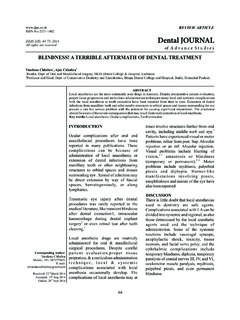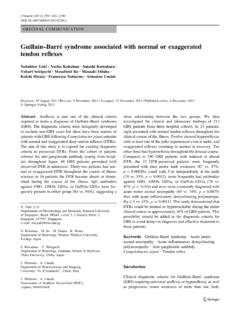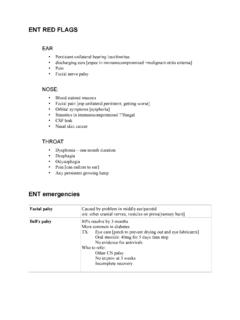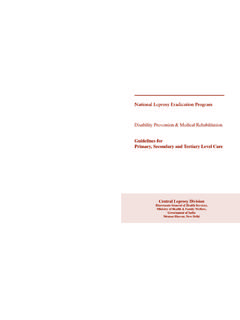Transcription of neurosarcoidosis: guidance for the general …
1 293 Views and ReViewsneurosarcoidosis: guidance for the general neurologistNeurosarcoidose: orienta es para o neurologista geralL via Almeida Dutra, Pedro Braga-Neto, Ricardo Ara jo Oliveira, Jos Luiz Pedroso, Agessandro Abrah o, Orlando Graziani Povoas BarsottiniSarcoidosis is an inflammatory multisystem disorder of unknown etiology with a worldwide distribution that can af-fect lungs, lymphatic system, skin, liver, eyes, and nervous sys-tem1. We owe the first recorded and illustrated description of sarcoidosis to Jonathan Hutchinson in 1878, when he report-ed a patient with a dermatologic disease, which comprised purplish, symmetric, and non-tender skin plaques, initially considered a manifestation of gout2. The term sarcoidosis comes from histological studies performed by Cesar Boeck, in 1899, who described pathological findings of skin lesions that resembled those of sarcoma, which he called sarkoid or sarcoma-like 3.
2 Involvement of the nervous system was first recognized, in 1905, by Winkler, and, in 1909, Heerfordt de-scribed three patients in the context of facial nerve palsies, uveitis, parotid enlargement, and fever1,3. neurosarcoidosis (NS) may involve any part of the ner-vous system with acute and chronic courses1,4. Cranial nerves, hypothalamus, and pituitary gland are the most commonly regions involved, but meninges, parenchyma, brainstem, and spinal cord may also be affected4. Clinical differentiation from other neurological diseases may be dif-ficult when an isolated involvement of the nervous system is present3,4. In this review, we highlighted its clinical forms, pathogenesis, and treatment guidelines for NS, as guidance for general ManiFesTaTiOns OF saRCOidOsisNeurologic manifestations are found in 5 to 20% of cases and symptoms may be mild or even severe, requiring a more aggressive intervention.
3 About one-half of patients with NS can develop neurologic manifestations before systemic sar-coidosis is evident5. Division of general Neurology, Department of Neurology and Neurosurgery, Universidade Federal de S o Paulo, S o Paulo SP, : L via Almeida Dutra; Rua Pedro de Toledo 650; 04039-000 S o Paulo SP - Brasil; E-mail: Conflict of interest: There is no conflict of interest to 02 October 2011; Received in final form 11 November 2011; Accepted 18 November 2011absTRaCTNeurosarcoidosis (NS) more commonly occurs in the setting of systemic disease. The diagnosis is based on a clinical history suggestive of NS, presence of noncaseating granulomas, and supportive evidence of sarcoid pathology, laboratory, and imaging studies. NS could involve any part of the nervous system and often demands high doses of steroids for symptom control. It presents low response to isolated steroids administration and frequently requires immunosuppressive agents.
4 In NS, lymphocytes are polarized toward an excessive Th1 response, leading to overproduction of TNF-alpha and INF-gama, as well as lL-2 and IL-15. Infliximab, a chimeric monoclonal antibody that neutralizes the biological activity of TNF-alpha, is a new option in the NS treatment. We revised pathophysiology, clinical manifestations, diagnostic work up, and treatment of NS as guidance for the general words: sarcoidosis, neurosarcoidosis , methotrexate, azathioprine, cyclophosphamide, neurosarcoidose (NS) ocorre frequentemente no contexto de doen a sist mica. O diagn stico baseado na hist ria cl nica sugestiva de NS, presen a de granulomas n o-caseosos e achados anatomopatol gicos, laboratoriais e radiol gicos de sarcoidose. A NS causa manifesta es neurol gicas variadas, que apresentam, em geral, baixa resposta ao corticoide isoladamente e, portanto, necessitam uso de imunossupressores.
5 Na NS, os linf citos est o polarizados para resposta Th1 excessiva, levando produ o aumentada de TNF-alfa e IFN-gama, assim como IL-2 e IL-15. Infliximabe, um anticorpo monoclonal quim rico que neutraliza a atividade biol gica do TNF-alfa, uma nova op o no tratamento da NS. Revisou-se a fisiopatologia, as manifesta es cl nicas, o diagn stico e o tratamento da NS para orientar neurologistas : sarcoidose, neurosarcoidose, metotrexato, azatioprina, ciclofosfamida, Neuropsiquiatr 2012;70(4):293-299 Hydrocephalus and chronic meningitisMeningitis may present as a single episode or as a recur-rent or chronic course. Cerebrospinal fluid (CSF) pleocyto-sis often occur in the setting of other manifestations, such as cranial neuropathy, myelopathy, mass lesions, or other focal neurologic manifestations. Granulomata in the fourth ven-tricle could be responsible for hydrocephalus, which may re-quire urgent treatment6.
6 Central nervous systemNS patients with headache may present meningitis, in-creased intracranial pressure or granulomatous mass lesions, which may mimic demyelination or neoplasm lesions7. In pa-tients with intraxial lesions, seizures are found in 5 to 22%, including generalized, complex partial and myoclonic sei-zures8. Hypothalamic and pituitary involvement is a char-acteristic feature of NS, and the posterior pituitary is more commonly affected than the anterior. Polydipsia and polyuria may be the presenting symptoms of NS secondary to diabe-tes insipidus. Other manifestations include hypothyroidism, amenorrhea, galactorrhea, sleep disorders, weight gain, tem-perature dysregulation, and personality changes. The possi-bility of endocrine dysfunction should always be investigated in the context of nonspecific complaints such as weight loss, fatigue and generalized with NS may present white matter abnormalities on the magnetic resonance imaging (MRI) (Fig 1) and pro-gressive multifocal leukoencephalopathy should be consid-ered as a differential diagnosis10.
7 Myelopathy in NS is unusu-al, often evolving over weeks to months, with radiculopathy or long tract dysfunction. Intramedullary sarcoidosis may present focal enlargement of the cord with gadolinium en-hancement. Progressive motor dysfunction may even mimic anterior horn syndrome10. Involvement of basal ganglia may lead to movement dis-orders, with rare reports linking sarcoidosis to Parkinsonism and generalized chorea11. Stroke, subarachnoid hemor-rhage, or intraparenchymal hemorrhage are quite rare in NS and may result from blood vessels involvement by sarcoid granulomas9,11. Most NS patients with increased intracrani-al pressure present mass lesions, meningitis, or venous sinus thrombosis. In despite of that, few reports described pseudo-tumor cerebri due to NS12. neuropsychiatric manifestationsPatients with sarcoidosis and extensive central ner-vous system (CNS) involvement may develop dementia, psychoses, depression, poor concentration, hallucina-tions, and encephalopathy.
8 Neuropsychiatry symptoms (NPS) develop months, sometimes presenting a relapse-remitting course. They can be found in sarcoid patients without evident CNS involvement. However, when NPS are found, CSF analysis is frequently abnormal, disclosing pleocytosis or increased protein13. Cranial and peripheral neuropathyThe most common cranial neuropathy in NS is facial pal-sy, which may represent an isolated manifestation or which can occur in the context of multiple cranial nerve involve-ment. NS should be considered when multiple cranial nerves are affected or in patients with bilateral facial palsy. The optic nerve is involved in up to 38% of NS patients and some may present a progressive and painless monocular visual loss, sometimes with papilledema or optic atrophy. Less often, an acute or subacute visual loss may occur. Retrobulbar optic neuritis mimics multiple sclerosis.
9 Approximately 20% of pa-tients have uveitis, usually bilateral, granulomatous that may be anterior (more common) or posterior14,15. Sarcoid patients may present hearing loss or vestibu-lar dysfunction due to acoustic neuropathy. Lower cranial nerves are more affected than those responsible for extraoc-ular movements (III, IV, and VI), determining dysphagia or dysarthria16. Involvement of the peripheral nerves is a well-recognized feature of NS, occurring in up to 20% of patients. Most of them present depressed tendon reflexes or minor sensory changes, although severe weakness may be found. The clinical presenta-tions mainly include symmetrical distal neuropathy, monon-europathy, mononeuritis multiplex, and acute or chronic de-myelinating polyneuropathy. The mechanism of nerve injury is unclear, with evidence for both axonal injury and demyeli-nation process.
10 Considering that some NS patients have pre-sented chronic inflammatory demyelinating polyneuropathy, Fig 1. Brain magnetic resonance images of patients with neurosarcoidosis . A: hydrocephalus; B: meningeal thickening involving sphenoid wings and temporal lobes; C: meningeal thickening involving cavernous sinus with gadolinium enhancement; D: involvement of the right cerebellar hemisphere; E: leukoencephalopathy of anterior temporal lobes; F: white-matter hyperintensities in cortico-subcortical regions of frontal lobes suggestive of LA et al. Neurosarcoidosissome authors believe that cytokines and immune factors may also play a role in nerve injury17. Peripheral neuropathy may be associated with myositis or CNS involvement of the skeletal muscle by sar-coid granulomas may occur in more than 50% of patients with sarcoidosis. Only 1 2% of the patients present symp-tomatic muscle disease.

















